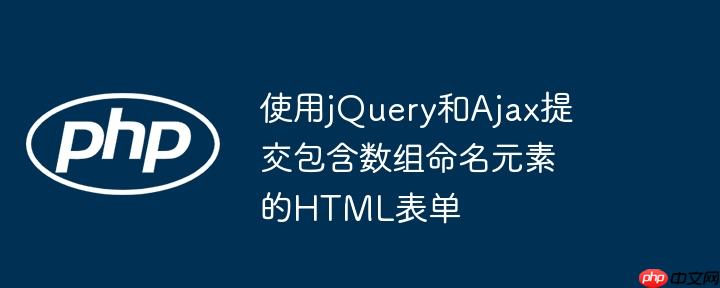
在web开发中,处理包含复杂结构(如列表或数组)数据的表单提交是一个常见需求。例如,一个表单可能需要提交多个“朋友”的信息,每个朋友又包含“姓氏”、“名字”和“邮箱”等字段。此时,html表单元素通常会采用数组形式的name属性,如name="friends[0][first_name]"。当使用ajax进行表单提交时,如何正确地将这些数据序列化并确保服务器端能够以预期的数组结构接收,是开发者经常面临的挑战。
挑战:处理数组命名元素
传统上,当HTML表单以标准方式提交时,浏览器会自动将name="friends[0][first_name]"这样的字段编码为friends%5B0%5D%5Bfirst_name%5D=value的形式,服务器端(如PHP)的$_POST超全局变量会自动将其解析为$_POST['friends'][0]['first_name']。
然而,在使用jQuery进行Ajax提交时,如果错误地尝试手动构建JSON对象或使用serializeArray()后进行JSON.stringify(),可能会导致数据在服务器端无法被$_POST直接解析为期望的数组结构,而是需要手动解析php://input流,增加了开发的复杂性。
解决方案:使用 jQuery.serialize()
jQuery提供了一个非常便利的方法serialize(),它专门用于将表单或一组表单元素序列化为标准URL编码的字符串,这正是服务器端(特别是PHP)解析$_POST数据所期望的格式。使用serialize()方法,可以确保包含数组命名(如friends[0][first_name])的表单数据被正确编码,从而在服务器端被自动解析为嵌套数组。
示例代码
以下是一个完整的示例,展示了如何使用jQuery.serialize()结合Ajax提交包含数组命名元素的表单。
立即学习“前端免费学习笔记(深入)”;
HTML 表单结构:
jQuery Ajax 提交代码:
jQuery(document).ready(function() {
// 监听表单的提交事件
jQuery("#invite-form").submit(function(e) {
// 阻止表单的默认提交行为,防止页面刷新
e.preventDefault();
// 使用 serialize() 方法将表单数据序列化为 URL 编码字符串
let formData = jQuery(this).serialize();
// 可以在 formData 中添加额外的数据,例如一个 action 参数
// 注意:如果 formData 是字符串,添加额外参数需要手动拼接
// 例如:formData += '&action=invite-friends';
// 或者,如果需要更复杂的结构,可以先转为对象再序列化
// let formObject = jQuery(this).serializeArray().reduce(function(obj, item) {
// obj[item.name] = item.value;
// return obj;
// }, {});
// formObject['action'] = 'invite-friends';
// formData = jQuery.param(formObject); // 使用 jQuery.param 再次序列化对象
console.log("提交的数据:", formData); // 打印序列化后的数据,例如:friends%5B0%5D%5Bfirst_name%5D=...
// 发送 Ajax 请求
jQuery.ajax({
type: "POST", // 使用 POST 方法,适合表单提交
url: 'invitation.php', // 服务器端处理脚本的 URL
data: formData, // 将序列化后的数据作为请求体发送
dataType: 'json', // 预期服务器返回的数据类型为 JSON
cache: false, // 禁用浏览器缓存
success: function(response) {
// 请求成功时的回调函数
console.log("服务器响应:", response);
if (response.success === true) {
alert("邀请成功!");
// 可以在这里处理成功后的UI更新
} else {
alert("邀请失败: " + response.message);
}
},
error: function(jqXHR, textStatus, errorThrown) {
// 请求失败时的回调函数
console.error("Ajax 请求失败:", textStatus, errorThrown);
alert("请求失败,请稍后再试。");
}
});
});
});PHP 服务器端处理 (invitation.php):
在服务器端,PHP会自动将jQuery.serialize()发送的URL编码数据解析到$_POST超全局变量中。
false, 'message' => '未知错误'];
// 检查是否是 POST 请求
if ($_SERVER['REQUEST_METHOD'] === 'POST') {
// 检查 $_POST['friends'] 是否存在且为数组
if (isset($_POST['friends']) && is_array($_POST['friends'])) {
$friends = $_POST['friends'];
// 遍历并打印接收到的朋友数据
echo "接收到的朋友数据:
";
foreach ($friends as $index => $friend) {
echo "朋友 " . ($index + 1) . ":
";
echo "- ";
echo "
- 姓氏: " . htmlspecialchars($friend['first_name'] ?? 'N/A') . " "; echo "
- 名字: " . htmlspecialchars($friend['last_name'] ?? 'N/A') . " "; echo "
- 邮箱: " . htmlspecialchars($friend['email'] ?? 'N/A') . " "; echo "
接收到 action: " . htmlspecialchars($_POST['action']) . "
"; } } else { $response['message'] = '只接受 POST 请求。'; } echo json_encode($response); // 返回 JSON 响应 ?>当上述jQuery代码执行时,jQuery(this).serialize()会将表单数据转换为类似friends%5B0%5D%5Bfirst_name%5D=John&friends%5B0%5D%5Blast_name%5D=Doe&...的字符串,并作为Ajax请求的data发送。PHP服务器在接收到这种格式的数据时,会自动将其解析为如下的$_POST结构:
$_POST = [
'friends' => [
0 => [
'first_name' => 'John',
'last_name' => 'Doe',
'email' => 'john.doe@example.com'
],
1 => [
'first_name' => 'Jane',
'last_name' => 'Smith',
'email' => 'jane.smith@example.com'
],
// ... 更多朋友数据
]
];注意事项和最佳实践
- e.preventDefault(): 这是至关重要的一步。在表单的submit事件处理函数中调用e.preventDefault()可以阻止浏览器执行表单的默认提交行为(即页面刷新),从而允许Ajax请求异步发送数据。
-
HTTP 方法 (type):
- 对于数据创建、更新或删除等会改变服务器状态的操作,应始终使用POST方法。
- GET方法通常用于获取数据,且有URL长度限制,不适合传输大量或敏感数据。
- 数据类型 (dataType): dataType: 'json'告诉jQuery预期服务器返回JSON格式的数据。如果服务器返回其他格式(如HTML或纯文本),请相应调整此参数。
- 错误处理 (error): 在Ajax请求中实现error回调函数非常重要,以便在请求失败(如网络问题、服务器错误)时能够捕获并处理异常,提供更好的用户体验。
- 服务器端验证: 尽管前端已经进行了序列化和提交,服务器端仍需对接收到的数据进行严格的验证和过滤,以防止恶意输入和安全漏洞。
- 额外数据: 如果除了表单数据外还需要发送其他参数(例如示例中的action: 'invite-friends'),可以直接将它们添加到data对象中,或者如果data是serialize()的字符串结果,则需要手动拼接字符串,或者先将serialize()的结果转换为对象,添加额外参数后再使用jQuery.param()重新序列化。
总结
通过简单地使用jQuery.serialize()方法,开发者可以高效且可靠地处理包含数组命名元素的HTML表单的Ajax提交。这种方法确保了数据以服务器端(尤其是PHP)期望的标准URL编码格式发送,从而简化了后端的数据解析工作,避免了手动解析复杂数据结构的麻烦。遵循本文提供的代码示例和注意事项,将有助于构建健壮且易于维护的Web应用程序。






























